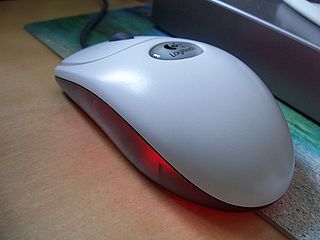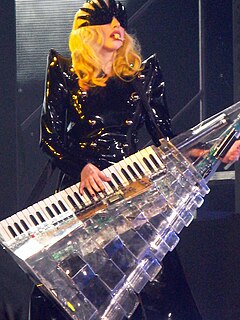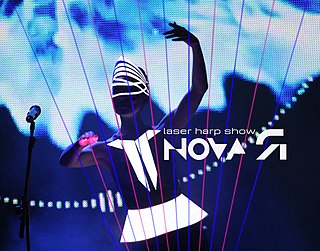Related Research Articles

An electronic musical instrument is a musical instrument that produces sound using electronic circuitry. Such an instrument sounds by outputting an electrical, electronic or digital audio signal that ultimately is plugged into a power amplifier which drives a loudspeaker, creating the sound heard by the performer and listener.

A joystick is an input device consisting of a stick that pivots on a base and reports its angle or direction to the device it is controlling. A joystick, also known as the control column, is the principal control device in the cockpit of many civilian and military aircraft, either as a center stick or side-stick. It often has supplementary switches to control various aspects of the aircraft's flight.

MIDI is a technical standard that describes a communications protocol, digital interface, and electrical connectors that connect a wide variety of electronic musical instruments, computers, and related audio devices for playing, editing and recording music. The specification originates in a paper published by Dave Smith and Chet Wood then of Sequential Circuits at the October 1981 Audio Engineering Society conference in New York City then titled Universal Synthesizer Interface.

A pointing device is an input interface that allows a user to input spatial data to a computer. CAD systems and graphical user interfaces (GUI) allow the user to control and provide data to the computer using physical gestures by moving a hand-held mouse or similar device across the surface of the physical desktop and activating switches on the mouse. Movements of the pointing device are echoed on the screen by movements of the pointer and other visual changes. Common gestures are point and click and drag and drop.

The theremin is an electronic musical instrument controlled without physical contact by the thereminist (performer). It is named after its inventor, Leon Theremin, who patented the device in 1928.

Stage lighting is the craft of lighting as it applies to the production of theater, dance, opera, and other performance arts. Several different types of stage lighting instruments are used in this discipline. In addition to basic lighting, modern stage lighting can also include special effects, such as lasers and fog machines. People who work on stage lighting are commonly referred to as lighting technicians or lighting designers.
A game controller, gaming controller, or simply controller, is an input device used with video games or entertainment systems to provide input to a video game, typically to control an object or character in the game. Before the seventh generation of video game consoles, plugging in a controller into one of a console's controller ports were the primary means of using a game controller, although since then they have been replaced by wireless controllers, which do not require controller ports on the console but are battery-powered. USB game controllers could also be connected to a computer with a USB port. Input devices that have been classified as game controllers include keyboards, mouses, gamepads, joysticks, etc. Special purpose devices, such as steering wheels for driving games and light guns for shooting games, are also game controllers.
A music sequencer is a device or application software that can record, edit, or play back music, by handling note and performance information in several forms, typically CV/Gate, MIDI, or Open Sound Control (OSC), and possibly audio and automation data for DAWs and plug-ins.

The Electro-Theremin is an electronic musical instrument developed by trombonist Paul Tanner and amateur inventor Bob Whitsell in the late 1950s to produce a sound to mimic that of the theremin. The instrument features a tone and portamento similar to that of the theremin, but with a different control mechanism. It consisted of a sine wave generator with a knob that controlled the pitch, placed inside a wooden box. The pitch knob was attached to a slider on the outside of the box with some string. The player would move the slider, thus turning the knob to the desired frequency, with the help of markings drawn on the box.

The keytar is a relatively lightweight synthesizer that is supported by a strap around the neck and shoulders, similar to the way a guitar is supported by a strap. Keytars allow players a greater range of movement onstage, compared to conventional keyboards, which are placed on stationary stands or which are part of heavy, floor-mounted structures. The instrument has a musical keyboard for triggering musical notes and sounds. Various controls are placed on the instrument's "neck", including those for pitch bends, vibrato, portamento, and sustain.

A MIDI controller is any hardware or software that generates and transmits Musical Instrument Digital Interface (MIDI) data to MIDI-enabled devices, typically to trigger sounds and control parameters of an electronic music performance.
The Rokenbok Toy Company was founded in 1995 by Paul Eichen in the United States to create an heirloom quality toy system. The first Rokenbok toys debuted at the 1997 American International Toy Fair in New York City. In 2010 the company made a substantial push researching the effect of media, like Rokenbok, on developing minds. In 2015 the company transitioned into a 501(c)(3) and completed the development of their first 4 classroom specific products called Mobile STEM Labs. Since then, Rokenbok Education has placed Mobile STEM Labs in over 22 states across the country.

The Roland MC-505 is a groovebox conceived in 1998 as a combination of a MIDI controller, a music sequencer and a drum machine, and also has some of the prime features of synthesizers: arpeggiator, oscillators, and voltage-controlled filter, control of attack, decay, sustain and release. It was released as the successor to the Roland MC-303 and is a compact version of the Roland JX-305 Groovesynth without the full set of 61 keys. It is also the predecessor to the Roland D2, Roland MC-307, Roland MC-909 and the Roland MC-808.

A laser harp is an electronic musical user interface and laser lighting display. It projects several laser beams played by the musician by blocking them to produce sounds, visually reminiscent of a harp. The laser harp has been popularised by Jean Michel Jarre, and has been a high profile feature of almost all his concerts since 1981. The laser harp became famous in Asia by Japanese artist Susumu Hirasawa.

The discontinued Roland MC-909 Sampling Groovebox combines the features of a synthesizer, sequencer, and sampler, with extensive hands-on control of both the sound engine and the sequencing flow. It was intended primarily for live performance of pre-programmed patterns consisting of up to 16 tracks of MIDI data. It was released by Roland Corporation on October 8, 2002. This product was announced at the AES Fall Convention in 2002. It is the direct successor to the Roland MC-505, and is the predecessor to the Roland MC-808 which eventually ended the "Groovebox" line of products by Roland which began in the mid 1990s with the original MC-303. It was developed from the blueprint of Roland's own "Fantom" workstation and uses the same structure and operating system, with some differences regarding the Patterns section, not implemented in the Fantom.

The Doepfer A-100 is an analog modular synthesizer system introduced by German audio manufacturer Doepfer in 1995. Although it only had 10 modules at time of release, it currently has more than 120 modules plus several different enclosures and accessories.
The SH-01 Gaia, is a sixty four voice polyphonic virtual analogue synthesizer introduced by Roland Corporation in 2010.
The HandSonic HPD-20 is a hand percussion pad introduced by the Roland Corporation. It can be played on its own or used as an addition to a larger drum kit. The dynamicpads are made of rubber to reduce fatigue on the hands. The rear panel includes a mix-in stereo input along with a stereo headphone output and two quarter inch jacks.
The Roland SP-808 GrooveSampler and SP-808EX/E-Mix Studio are both discontinued workstations, which function as digital samplers, synthesizers, and music sequencers. The digital samplers are a part of the long line of both Roland Corporation's and Boss Corporation's Groove Gear, which includes the more popular and successful Boss SP-303 and Roland SP-404 versions.
The VK-8 Combo Organ is a discontinued electronic keyboard introduced in 2002, which simulates the sound of an electromechanical tonewheel-based Hammond organ. The VK-8 is both an improvement and successor to both the VK-7 and VK-77. The VK-8 itself was succeeded by the VK-88.